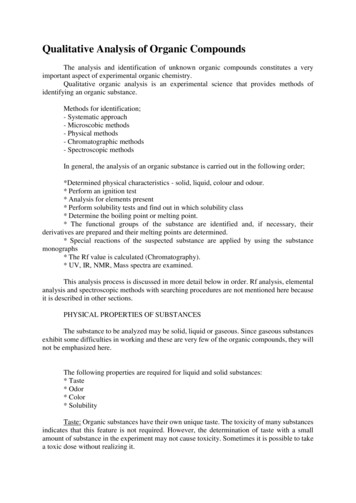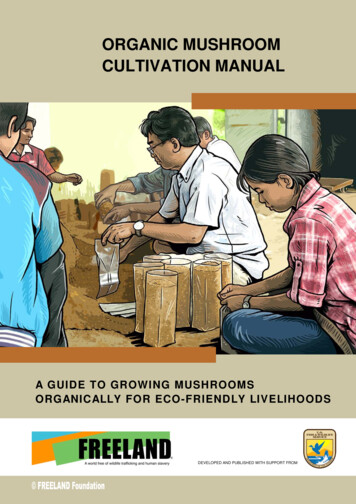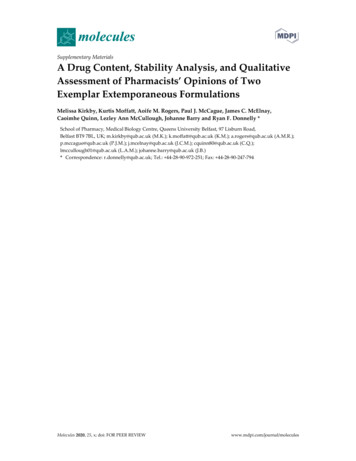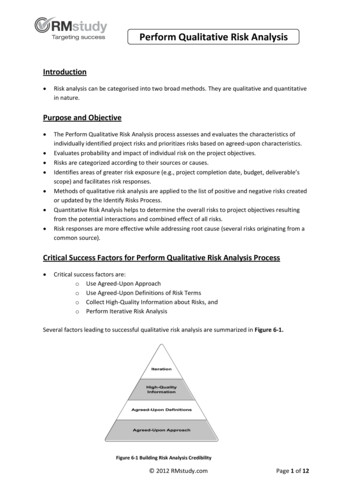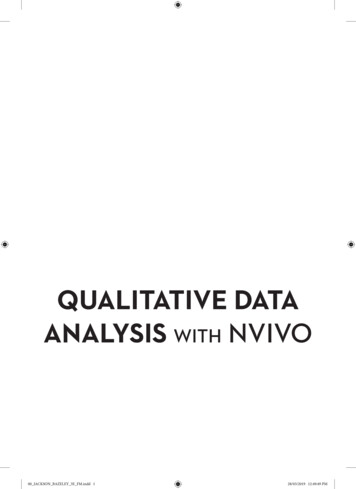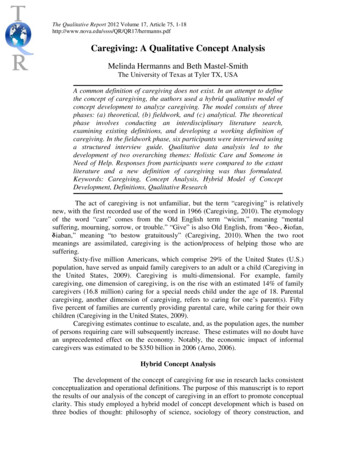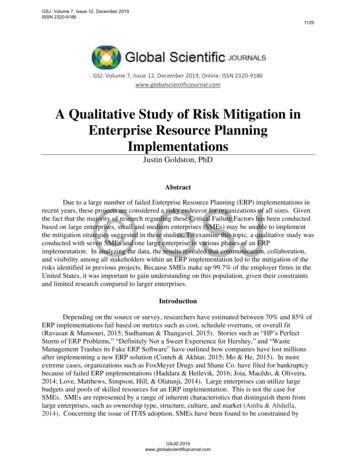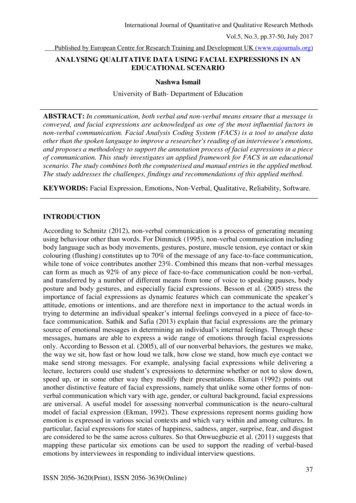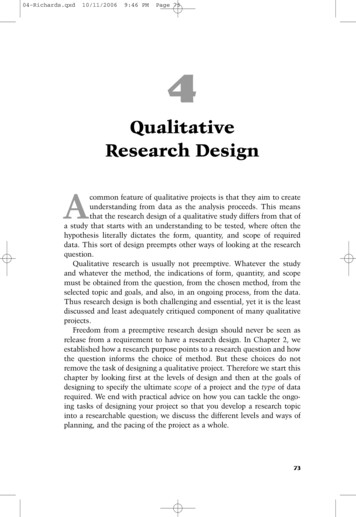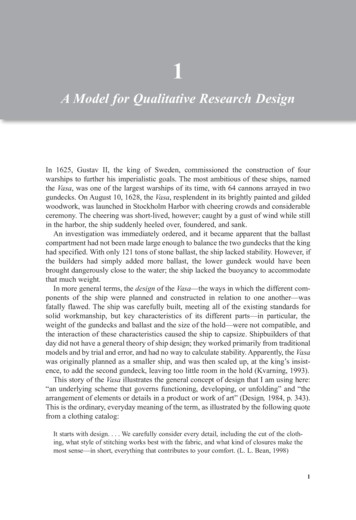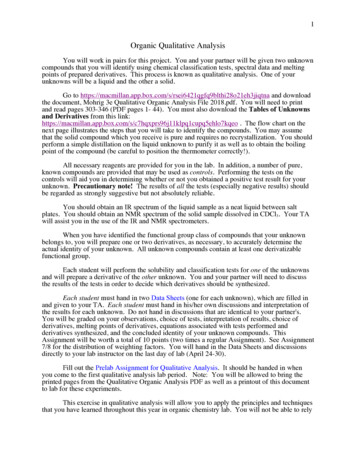
Transcription
1Organic Qualitative AnalysisYou will work in pairs for this project. You and your partner will be given two unknowncompounds that you will identify using chemical classification tests, spectral data and meltingpoints of prepared derivatives. This process is known as qualitative analysis. One of yourunknowns will be a liquid and the other a solid.Go to 28o21eh3jiqtna and downloadthe document, Mohrig 3e Qualitative Organic Analysis File 2018.pdf. You will need to printand read pages 303-346 (PDF pages 1- 44). You must also download the Tables of Unknownsand Derivatives from this klpq1cupq5ehlo7kqeo . The flow chart on thenext page illustrates the steps that you will take to identify the compounds. You may assumethat the solid compound which you receive is pure and requires no recrystallization. You shouldperform a simple distillation on the liquid unknown to purify it as well as to obtain the boilingpoint of the compound (be careful to position the thermometer correctly!).All necessary reagents are provided for you in the lab. In addition, a number of pure,known compounds are provided that may be used as controls. Performing the tests on thecontrols will aid you in determining whether or not you obtained a positive test result for yourunknown. Precautionary note! The results of all the tests (especially negative results) shouldbe regarded as strongly suggestive but not absolutely reliable.You should obtain an IR spectrum of the liquid sample as a neat liquid between saltplates. You should obtain an NMR spectrum of the solid sample dissolved in CDCl3. Your TAwill assist you in the use of the IR and NMR spectrometers.When you have identified the functional group class of compounds that your unknownbelongs to, you will prepare one or two derivatives, as necessary, to accurately determine theactual identity of your unknown. All unknown compounds contain at least one derivatizablefunctional group.Each student will perform the solubility and classification tests for one of the unknownsand will prepare a derivative of the other unknown. You and your partner will need to discussthe results of the tests in order to decide which derivatives should be synthesized.Each student must hand in two Data Sheets (one for each unknown), which are filled inand given to your TA. Each student must hand in his/her own discussions and interpretation ofthe results for each unknown. Do not hand in discussions that are identical to your partner's.You will be graded on your observations, choice of tests, interpretation of results, choice ofderivatives, melting points of derivatives, equations associated with tests performed andderivatives synthesized, and the concluded identity of your unknown compounds. ThisAssignment will be worth a total of 10 points (two times a regular Assignment). See Assignment7/8 for the distribution of weighting factors. You will hand in the Data Sheets and discussionsdirectly to your lab instructor on the last day of lab (April 24-30).Fill out the Prelab Assignment for Qualitative Analysis. It should be handed in whenyou come to the first qualitative analysis lab period. Note: You will be allowed to bring theprinted pages from the Qualitative Organic Analysis PDF as well as a printout of this documentto lab for these experiments.This exercise in qualitative analysis will allow you to apply the principles and techniquesthat you have learned throughout this year in organic chemistry lab. You will not be able to rely
2on your lab instructor for help every step of the way. The lab TA will not be able to answerquestions such as “what test should I do next?” and “is this a positive or negative result?” bothbecause s/he could inadvertently steer you in the wrong direction and because you must learn totrust your own judgment and make your own decisions in a problem solving process such as this.Flow Chart for Identification of Organic CompoundsObservations of physical propertiesLiquidSolidMelting point detn.Boiling point detn.Ignition TestBeilstein test for HalogensSolubility testsFunctional group classification testsSolidSpectral AnalysisLiquidNMR spectrumDerivative(s) synthesisIR spectrumGeneral NotesOnly deionized water (from the white taps) should be used throughout the qualitativeanalysis procedures. Impurities in tap water could lead to “false positive” results.One drop of a liquid is equivalent to approximately 10-20 mg of a solid. When using amedicine dropper, you can assume that 20 drops is approximately equivalent to 1 mL. Whenusing a Pasteur pipet, between 30 and 40 drops is equivalent to 1 mL.*It is a good idea to double the amounts called for in the text when preparing your derivatives.*
3Ignition TestThe ignition test, found on p. 331, will give you an indication as to whether or not yourunknown compound is aromatic.Beilstein Test for HalogenYou must perform the Beilstein test for halogens as described on p. 335.Additional notes on the solubility tests (pp 309-314)1. If a reaction occurs when a solvent is added to a compound, as evidenced by a colorchange for instance, the compound is considered to be soluble in that solvent.2. Even if your compound appears not to dissolve in water, it is a good idea to check thepH of the supernatant. A small amount of the compound may have dissolved andaltered the pH.3. If any amount of the compound appears to dissolve in a particular solvent, consider itto be soluble in that solvent.Refluxing proceduresWhen a reaction mixture must be refluxed on a micro- or small scale, three options areavailable to you.1) Obtain a 5 mL long-neck round bottom flask. Wrap a cold, wet paper towel aroundthe neck, which will serve as the condenser.2) Obtain a 5 mL long-neck round bottom flask and a microscale chromatographycolumn. Attach the column to the flask with a rubber connector (from yourmicroscale kit). The column will serve as an air-cooled condenser.3) Obtain a 10 mL round bottom flask with a 19/22 ground glass connection. Attach acondenser from your drawer and run water through it.A note on the tests for Alkenes (p. 329)Dichloromethane is a suspected carcinogen and has harmful effects on the ozone layer ofthe atmosphere. We are limiting the use of this solvent in the teaching labs, and therefore thebromine reagent for this test will not be available. You may use the other test for alkenes,Oxidation with Potassium Permanganate, described on pp 329-330.The Hinsberg Test for Amines (p. 330)Read the paragraph on page 330 labeled Amines. The following test should distinguishbetween primary, secondary and tertiary amines:Place 100 mg or 8 drops of amine in a 13x100 mm test tube, add 6 drops ofbenzenesulfonyl chloride and 2 mL of methanol. Heat the mixture to just below the boilingpoint (in a hot water bath), cool, and add 4 mL of 6 M sodium hydroxide. Shake the mixtureconstantly for 5 minutes. Allow the mixture to stand for 10 minutes with occasional shaking.Cool the mixture, then add 6 M hydrochloric acid dropwise with stirring until the pH is acidic.If a precipitate is seen, the amine is either primary or secondary. If no precipitate is seen, eitherthe amine is tertiary, or the compound being tested is not an amine.If a precipitate is present, collect it by vacuum filtration and wash with water. Place thissolid in a reaction tube and add 3 mL of 2.5 M sodium hydroxide. Heat to 50 , shaking the tubevigorously for 2 minutes. If the precipitate dissolves, the amine is primary. If it does notdissolve, it is secondary.The Hinsberg test is based on the ability of benzenesulfonyl chloride to formsulfonamides with primary and secondary amines. In general, tertiary amines do not react withbenzenesulfonyl chloride because they lack an acidic hydrogen.
4Sulfonamides that are formed from primary amines have an acidic hydrogen and aretherefore soluble in basic solution.OSOCl H2NR NaOHSOOROH NaOHNNaSR NaCl H2ONOOSH H2ONROSulfonamides formed from secondary amines are insoluble in base because they lack thisacidic hydrogen:OSRONo Reaction NaOHNRSilver Nitrate Test: An additional test for the presence of halides (p. 335)Dissolve 1 drop or 10 mg of the compound to be tested in a drop or two of ethanol. Add1 mL of 0.1 M silver nitrate in ethanol. The formation of a precipitate is a positive indication ofthe presence of halide. If there is no reaction at room temperature within 5 minutes, heat themixture to the boiling point in a water bath for 3-4 minutes. If a precipitate forms, note itscolor. Silver iodide is yellow, whereas silver chloride and silver bromide are white.Add 2 drops of 1 M nitric acid. If the precipitate dissolves, it is not a silver halide (someorganic acids produce insoluble silver salts that will dissolve in nitric acid). For reference, trythe test on bromocyclohexane, bromobutane, 2-chloro-2-methyl propane (t-butyl chloride), andchlorobenzene.Silver nitrate reacts instantaneously with compounds that react quickly with ethanol toproduce halide ions. Other compounds react with silver nitrate because they easily formcarbocations in an SN1 process. The table on the next page summarizes the reactions of varioushalides (X Cl, Br or I) with ethanolic silver nitrate. The overall reaction is:RX Ag EtOHROCH2CH3 AgX (s) alkenesReacts at room tempReacts at higher tempRCH CHCH2XR3CXRIRBrRCH2ClR2CHClRCHBr2ORCClArCH2XO2NNo reactionArXRCH CHXHCCl3XNO2OR C CH2X
5Notes for tests for Phenols (pp 335-6)The Reaction with Bromine/Water test is best for water soluble compounds while theReaction with Ferric Chloride test is best for water insoluble compounds.For the ferric chloride test, use 5-6 drops of the ferric chloride in chloroform solutioninstead of 3 drops. For a reference compound, try bromophenol.The Ferrous Hydroxide Test for a Nitro GroupAlthough nitro compounds will not be issued as distinct unknowns, many of theunknowns may have a nitro group as a secondary functional group. The presence of a nitrogroup in an unknown compound may be determined by means of infrared spectroscopy. Thenitro group gives two strong bands near 1560 cm-1 and 1350 cm-1.Most nitro compounds will oxidize ferrous hydroxide to ferric hydroxide, which is a redbrown solid:RNO2 6 Fe(OH)2 4 H2O RNH2 6 Fe(OH)3red-brown ppt.Prepare 25 mL of deoxygenated water by boiling it on a hot plate. Dissolve 1.25 g offerrous ammonium sulfate hexahydrate in this boiled water. In a small test tube, place 1 drop ofliquid or 10 mg of solid unknown and 1.5 mL of the freshly prepared 5% aqueous solution offerrous ammonium sulfate. [Note: You may share your remaining ferrous ammonium sulfatesolution with another pair of students.] Mix the solution well and add first one drop of 1.5 Msulfuric acid, then 1 mL of 2 M potassium hydroxide in methanol. Stopper the test tube andshake it vigorously. The appearance of a red-brown precipitate of ferric hydroxide within oneminute is a positive test. Almost all nitro compounds give a positive test within 30 seconds. Thespeed with which the nitro compound is reduced depends on its solubility. A negative test isindicated by a greenish precipitate.Carboxylic Acid Derivatives (pp 342-345)Use 1 mL of thionyl chloride instead of 0.3 mL. Care should be taken when usingthionyl chloride. Read the hazards listed on the bottom of p. 342 carefully. Wear gloves andwork in a fume hood. Do not carry an uncapped bottle or flask that contains thionylchloride away from a fume hood.In Step 2: Preparation of Anilides and Toluidides (p. 344), follow the “dichloromethane-free” procedure described below:Dissolve 0.5 mL of aniline or 0.5 g of 4-toluidine in 9 mL of toluene, and carefully (bydrops and with stirring) add it to the cooled acyl chloride reaction mixture. Warm themixture on a steam bath. Wash the mixture (in either a separatory funnel or centrifugetube) with the following solutions in the order written:3 mL water3 mL of 1.5 M HCl solution3 mL of 2.5 M NaOH solution3 mL waterDry the toluene layer over calcium chloride or sodium sulfate. Filter off the drying agentand collect the filtrate in a side-arm flask. In a fume hood, remove the solvent byevaporation under vacuum. Recrystallize the solid residue in the flask using water or anethanol-water mixture.See p. 7 of this document for a table of the Toluidide derivatives (they are missing from theAppendix pages at the website).
6Amine DerivativesThere are three options available for making amine derivatives.Benzamides Dissolve 0.15 g of amine in 1.5 mL of pyridine (Caution: Toxic andunpleasant odor. Wear gloves and use only in fume hood.) and 3.0 mL of toluene in a 10mL round-bottomed flask. Add 0.3 mL of benzoyl chloride (Caution: Lachrymator and skinirritant. Use only in fume hood.) to the flask. Attach a condenser fitted with a drying tube tothe flask. Heat the reaction mixture on a steam bath or in a boiling water bath for 20 minutes,and then pour it into 20 mL of water. Transfer half of the mixture to a centrifuge tube with atight fitting cap. Remove the lower aqueous phase with a Pasteur pipet, leaving the toluene layerin the centrifuge tube. Add the rest of the water/toluene mixture and remove the lower aqueousphase. Wash the toluene layer with 5 mL of 0.5 M Na2CO3 solution (Caution: Foaming.) Drythe organic layer with anhydrous sodium sulfate and remove the solvent by evaporation.Recrystallize the crude benzamide from ethanol or an ethanol/water mixture.Primary and secondary amines form solid benzamides upon reaction with benzoylchloride:OOCCl RNH2CNHR HClBenzenesulfonamides Place 0.3 g of the amine in a dry test tube, then add 0.3 mL ofbenzenesulfonyl chloride (Caution: Corrosive, lachrymator. Wear gloves and use only infume hood.) and 6 mL of 2.5 M NaOH solution. Close the test tube with a rubber stopper andshake it intermittently for 3-5 minutes. Cautiously, acidify the reaction mixture with 6 M HCl toa pH of 5. Collect the crystals
Ignition Test The ignition test, found on p. 331, will give you an indication as to whether or not your unknown compound is aromatic. Beilstein Test for Halogen You must perform the Beilstein test for halogens as described on p. 335. Additional notes on the solubility tests (pp 309-314) 1. If a reaction occurs when a solvent is added to a compound, as evidenced by a color
